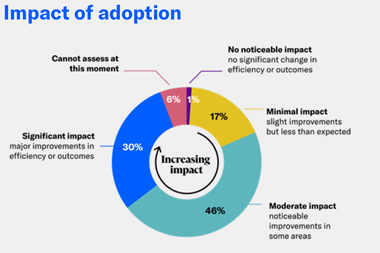Where are the best opportunities to be found among emerging markets? And what about the risks? Ian Coleman explains the thinking behind an index which balances the risks and rewards
Globalisation opens up great opportunities for businesses, but also brings significant strategic risks. Both must be assessed as part of any overseas investment appraisal.
The economic landscape is changing, with new economic forces coming into play. Established players, such as the US, the UK, Japan and Germany, have challengers to their economic power.
As globalisation proceeds, all businesses, wherever they are located, need to appreciate and prepare for the impact of changing trade flows and investment patterns. Not competing in overseas markets does not guarantee insulation from them. A local market can become dominated by overseas competitors – witness the UK textile industry, once thriving but now marginalised. Could UK companies have stayed in the game by making strategic investments in India or Indonesia?
Reasons for investing overseas will vary. Some businesses will want to access low cost manufacturing locations, while others may be drawn to a new base of increasingly wealthy customers. Investing in emerging markets has become an important part of modern business strategic planning. But choosing the right markets remains a major challenge.
Recognising the strategic importance of investment in emerging markets, PricewaterhouseCoopers developed the EM20 Index. It aims to provide a balanced view of a market's potential, by incorporating both risk and reward in a discounted cash flow model.
Understanding the balance, or trade-off, between risk and reward is important. Much commentary on emerging markets tends to take a polarised view – markets are seen as either highly attractive locations in which the intrepid investor can reap high rewards, or they are risky places where entrants may get their fingers burned.
But real life is rarely so cut and dried. Investing in emerging markets requires an understanding that there could be major advantages attached to a location – such as a plentiful, low-cost workforce and little red tape – as well as some significant disadvantages – an uncertain political environment or large distances to key markets.
The art of successful investment begins with understanding the characteristics of particular markets, to identify those that best suit the type of business investment envisaged.
The EM20 Index model
The EM20 Index focuses on 20 emerging markets, chosen primarily because of the size of their economies, but also to give a reasonable geographical coverage across the world.
For the Index, simple discounted cash flow models for stylised manufacturing and services businesses were created based upon a number of key assumptions. For example, it was assumed that a manufacturing business would export 50% of its sales, while a services business would provide 90% of its service to the domestic market where it is located.
“In terms of attractiveness for service business investment, China loses its lustre
Present values per US dollar invested were then calculated for both the stylised manufacturing and services businesses in each country. Cash flows for each investment were projected over an assumed 30 year lifetime, taking account of the initial investment, revenues, costs (including transport costs to key markets), tariffs and corporate taxes. Initial income levels (GDP per capita) and projected economic growth were also factored in. These cash flows were then discounted back to present values using discount rates taking account of factors such as the risk-free rate, country risk premia, equity market risk premia, tax and gearing. The country risk premia were derived from bond market data using a proprietary PricewaterhouseCoopers methodology. Where no bond market data was available, synthetic estimates were produced in relation to other information, such as the credit ratings and country risk scores issued by other organisations.
The present values generated were then expressed as a ratio of the dollar amount initially invested (which varied across countries, to the extent that initial investments were assumed to be made at local prices). The resulting present values per initial dollar invested were then converted into an index on a scale of zero to 100. Locations with high index values are therefore those which are the more attractive in terms of business opportunities, as measured by the present value of each investment dollar.
Surprising findings?
The results of the EM20 Index analysis are set out in Figure 1, with separate rankings for the manufacturing and the services business models.
Unsurprisingly, countries that ranked highest in the EM20 Index for manufacturing are low-cost economies. Similarly, it is to be expected that countries with high GDP per capita would do well in the services ranking. However, a closer look at the results reveals the effect that risk factors have on the rankings – the impact of pure cost and income is modified by risk to produce a rather more refined evaluation.
It is notable, for example, that neither China nor India tops the EM20 Index manufacturing rankings. Though both markets are hugely important because of their sheer size, they may not always offer the highest risk-adjusted returns. In the ranking for manufacturing investments, it is Vietnam that takes top position.
Its success illustrates the interplay between risk and reward in the EM20 Index. The country is highly cost competitive and offers investors the highest potential returns. Although it is also the fourth riskiest investment location within the 20 markets considered, the potential rewards are so great they offset Vietnam's relatively high risk premium.
The EM20 Index findings appear to chime with much current corporate thinking and activity. Global companies are already acting on the opportunities that exist in Vietnam. High-profile organisations that have already invested in the country include Intel, Procter & Gamble, Conoco, Akzo Nobel, Unilever and SAB Miller.
However, the EM20 Index shows that good opportunities exist across a range of locations. Markets that often attract corporate attention include China, India, Russia, the Middle East and Central and Eastern Europe. How did they fare?
n China Although pushed into second place in the manufacturing rankings, China remains a highly attractive location for manufacturing investment. It earned an index value of 95, largely as a result of its low costs, which translate into relatively high returns. The country also benefits from a comparatively low risk rating among the sample countries.
However, in terms of attractiveness for service business investment, China loses its lustre – coming 14th in the EM20 Index services rankings with a value of just 17. The main reason for this is the relatively low GDP per head. It is worth highlighting here that the EM20 Index focuses only on average incomes. A huge population can mask the presence of a sizeable group of wealthy potential customers – and also a significant disparity in wealth within a population. As Suwei Jiang from PricewaterhouseCoopers UK-based China desk points out: 'There is a growing affluent class in China, which is attracting the attention of luxury goods companies. Financial services players are also appreciating that the local market is currently under-developed and that huge opportunities exist.' However, there is a major imbalance between urban and rural markets, with associated political implications. Further, rapid development in cities is creating environmental challenges, which need to be addressed.
“Investing in emerging markets has become an important part of modern business strategic planning
n India India achieved seventh place in the EM20 Index manufacturing rankings. It benefits from relatively low costs but suffers from high tax rates and above average country risk. It is also a significant distance from export markets in both the US and the European Union, resulting in higher than average transport costs.
Like China, India also performs less well in the services ranking, coming 18th, with a value of just five. This may appear surprising, given India's popularity as a location for offshoring operations such as call centres. However, these are not the kinds of services business considered in the EM20 Index. The stylised EM20 Index services business is assumed to focus on the domestic market, not customers who are geographically remote (as with call centres), therefore factors pertinent to offshoring investments, such as the availability of English language skills, are not so relevant.
India's position in the services rankings would be expected to improve as income levels increase. Mukesh Rajani from PricewaterhouseCoopers UK-based India desk says: 'There is already a fairly well established luxury goods market in India, recognising the many wealthy members of the population. At the same time there are opportunities to provide very cheap, mass market goods. However, India is not without its infrastructure challenges.' India's infrastructure is suffering from past under-investment, while future investment decisions are often frustrated by the federal structure of the Indian political system.
n Russia Relatively high country risk is largely the reason for Russia's 11th place in the manufacturing rankings. It does somewhat better in the services rankings, coming seventh. This placing essentially reflects its status as a middle income country. Overall uncertainty remains about the freedom that businesses will have to operate, and this is an issue that investors will need to consider.
n Middle East Middle Eastern markets such as the United Arab Emirates (UAE) and Saudi Arabia do well in the services rankings, coming first and second respectively with values of 95 and 70.
The UAE's success reflects its extremely high GDP per head – but this also accounts for its poor performance in the manufacturing rankings. Nevertheless, for services businesses, including leisure and construction, opportunities in the UAE are excellent, assisted by its relatively low country risk. Dubai's International Financial Centre, for example, has attracted companies such as Barclays, HSBC, Citigroup and Standard Chartered.
Saudi Arabia also benefits from its very low statutory tax rate (2.5%). With 25 million citizens, the country has attracted the attention of global financial services companies, such as Citibank, HSBC, Deutsche Bank and BNP Paribas, who have all secured banking licences there. Saudi Arabia also does fairly well in the manufacturing rankings, coming tenth as, although the country's own citizens enjoy relatively high incomes, there is a significant number of low-wage migrant workers, resulting in cost levels somewhat lower than might be expected.
n Central and Eastern Europe Among the European countries included in the sample of 20 emerging markets, Poland comes highest in the manufacturing ranking, at fifth (with a score of 94). Its positioning largely reflects its low-cost labour relative to Hungary and the Czech Republic (ranked ninth and 17th respectively). Poland also benefits from its proximity to the export markets of the EU in particular.
In the services rankings, the Czech Republic, Hungary and Poland cluster together in the upper ranks, at fourth, fifth and sixth. The Czech Republic earned a services value of 56, largely a result of its relatively high per capita income and relatively low risks. Hungary and Poland are both middle income countries, Hungary benefiting from its relatively low statutory corporate tax rate.
Analysis over time
While the EM20 Index enables different emerging markets to be compared at any one point in time, it will also enable changes in any particular market's attractiveness to be monitored over a longer period. As the EM20 Index is updated, changes in economic fundamentals and risk assessments will feed through into the rankings.
“Even a thorough analysis of economic data is not enough to guarantee successful investment
For example, as an economy develops, its wage rates may rise and so cost competitiveness will decrease as a consequence. However, at the same time, GDP per capita may rise, in turn creating more attractive domestic services markets. Various factors could also impact the country's risk rating, having either a positive or negative impact on its attractiveness, driving locations to rise or fall in the rankings.
Analysis in context
The EM20 Index is a modelled index, as opposed to one based on surveys. It is driven by objective data, rather than subjective feedback. This is not to say that survey-based research has no value for businesses planning overseas investment. It can provide intriguing insights into current business thinking and preferences – for example, what the competition is doing and what they believe will happen.
For example, the Global Competitiveness Index (GCI) issued by the World Economic Forum might be appropriate to assess a country's competitiveness. This index draws on a mixture of hard data and an extensive survey of business leaders, and aims to provide an overview of factors that are critical to productivity and competitiveness in individual countries. In the GCI 2006 rankings, Switzerland took the lead position, ahead of Finland and Sweden. The US came sixth and the UK tenth.
PricewaterhouseCoopers also conducts a range of qualitative research including an annual global CEO survey. The latest edition, based on interviews with over 1,000 CEOs from around the world, found that business leaders see that globalisation offers opportunities for new market penetration, acquisition and innovation. Nearly half of survey respondents had completed, were in the process of completing or were planning to complete cross-border M&A transactions. However, they also appreciated the challenges and risks involved.
Asked about the obstacles to successful M&A activity, a notable 45% of all CEOs said they had encountered or anticipated encountering cultural obstacles. Other challenges included sharing and building knowledge, nurturing management talent, managing an increasingly dispersed value chain and responding to competition.
A rounded risk assessment
Such findings confirm that even a thorough analysis of economic data is not enough to guarantee successful investment in any market, let alone an emerging one. There are many other issues, including cultural ones, to be considered. Risks associated with every stage of an investment need to be addressed. PricewaterhouseCoopers SMILE™ framework has been developed to remind executives of the different stages involved in an investment, to help ensure no issues are overlooked.
This approach is all part of a holistic investment appraisal and implementation plan. Properly risked, discounted cash flow calculations are essential, but so too are risk assessments of the whole range of issues that affect the potential success of a business investment. These include the extent of suitable skills, language capability, local regulatory environment, culture and other variables.
Knowledge gained on the ground will be invaluable. During implementation, both sides of the investment equation must again be addressed – how to address risks and maximise opportunities. Only by applying a reasoned and balanced view can the chances for success be optimised.
SMILEâ„¢ framework
PricewaterhouseCoopers developed the SMILEâ„¢ framework to help businesses address the full range of risks related to investment in an emerging market.
The SMILEâ„¢ framework focuses on five key stages and the issues that need to be considered for each:
- Strategic assessment understanding and developing strategic objectives.
- Market assessment understanding market characteristics and potential is essential before taking any decision to invest, and when devising effective entry strategies.
- Investment structuring identifying the most appropriate operating models for the investment type and rationale, whether manufacturing, outsourcing, sales or distribution. The aim is to optimise growth and post-tax profitability.
- Layout and infrastructure building or upgrading the required support infrastructure to get the business running efficiently, as well as developing incentives, reporting and control mechanisms to keep it successful.
- Entity operations building robust and cost-effective controls around operations to maximise performance levels and minimise the likelihood of underperformance, irregularities and fraud.
While particular attention can be given to one area, thinking about all five is the best way to develop a systematic approach to the key risks. Plans can be devised to address those risks before they turn into problems. This then allows a stronger focus on developing opportunities to drive growth and profitability.
Postscript
Ian Coleman is head of the emerging markets group at PricewaterhouseCoopers LLP, www.pwc.com



















